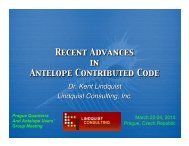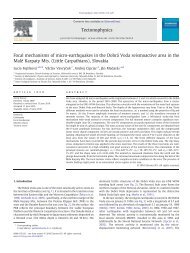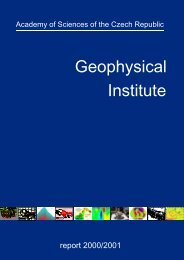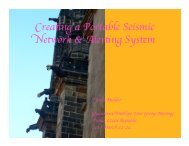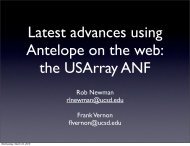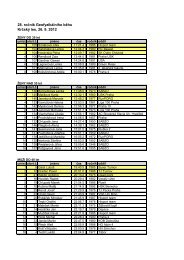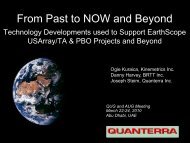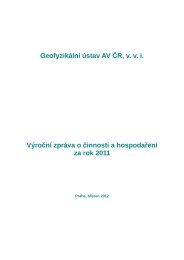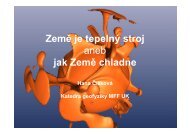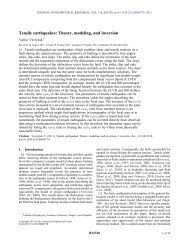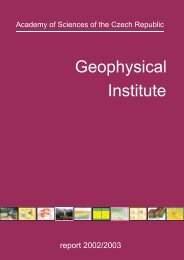Geophysical Institute of the ASCR
Geophysical Institute of the ASCR
Geophysical Institute of the ASCR
You also want an ePaper? Increase the reach of your titles
YUMPU automatically turns print PDFs into web optimized ePapers that Google loves.
in <strong>the</strong> Bohemian Massif and Central Europe and coincides with <strong>the</strong> results <strong>of</strong> <strong>the</strong> main Variscan<br />
tectonic events in that area. This indicates that <strong>the</strong> anisotropy is caused predominantly by alignment <strong>of</strong><br />
textural elements and minerals in <strong>the</strong> rocks, which developed in early geological stages ra<strong>the</strong>r than by<br />
a preferred orientation <strong>of</strong> cracks or microcracks due to present-day stress.<br />
References<br />
Vavryčuk V., Hrubcová P., Brož M., Málek J., and <strong>the</strong> ALP 2002 Working Group, 2004. Azimuthal variation <strong>of</strong> Pg velocity<br />
in <strong>the</strong> Moldanubian, Czech Republic: observations based on a multi-azimuthal common-shot experiment.<br />
Tectonophysics 387, 189-203.<br />
Search for triggering mechanisms and driving forces <strong>of</strong> earthquake<br />
swarms in <strong>the</strong> western part <strong>of</strong> <strong>the</strong> Bohemian Massif by <strong>the</strong> WEBNET<br />
group<br />
Forces and mechanisms accountable for origin and development <strong>of</strong> <strong>the</strong> earthquake swarms in <strong>the</strong> West<br />
Bohemia/Vogtland region are <strong>the</strong> issue for understanding <strong>the</strong> geodynamics <strong>of</strong> <strong>the</strong> Western Part <strong>of</strong> <strong>the</strong><br />
Bohemian Massif. Seismic observations <strong>of</strong> <strong>the</strong> recent intensive 2000-swarm, which occurred in <strong>the</strong><br />
main focal zone <strong>of</strong> <strong>the</strong> West Bohemia/Vogtland earthquake swarms – <strong>the</strong> area <strong>of</strong> Nový Kostel in <strong>the</strong><br />
period from August to December 2000, has been a proper base for investigation <strong>of</strong> triggering<br />
mechanisms and driving forces <strong>of</strong> <strong>the</strong> swarm. More than 20 000 earthquakes <strong>of</strong> magnitudes ML ≤ 3.4<br />
were recorded by 8 permanent and 3 temporary local stations. The swarm took place in nine swarm<br />
phases isolated by quiescence periods and showed a pronounced bottom => top => bottom and<br />
north => south migration along <strong>the</strong> fault plane (Fischer, 2003). The recent investigation <strong>of</strong> <strong>the</strong> 2000-<br />
swarm was focused to (a) precising <strong>the</strong> earthquake locations and determining <strong>the</strong> focal mechanisms;<br />
(b) search for possible driving forces by analysis <strong>of</strong> interactions between subsequent events;<br />
(c) analysis <strong>of</strong> multiple-events showing complex rupture process.<br />
a) Over 5400 well-recorded swarm events were relocated by <strong>the</strong> master event method and for <strong>the</strong> 133<br />
largest, M ≥ 1.7 swarm earthquakes focal mechanisms were determined. The majority <strong>of</strong> focal<br />
mechanisms were, respectively, oblique strike-slips with average strike, dip and slip values <strong>of</strong><br />
164°, 70° and -30°, which correspond very well<br />
to <strong>the</strong> geometry <strong>of</strong> <strong>the</strong> Nový Kostel focal zone,<br />
and showed sinistral movements (Fischer and<br />
Horálek, 2005).<br />
b) The presence <strong>of</strong> causal relationship <strong>of</strong> <strong>the</strong> swarm<br />
earthquakes was examined based on <strong>the</strong> spacetime<br />
relations between consecutive events – <strong>the</strong><br />
prior event and <strong>the</strong> immediate aftershock (IA),<br />
(Fischer and Horálek, 2005). For this purpose we<br />
determined relative position vectors and interevent<br />
times for each consecutive event pair. The<br />
spatial distribution <strong>of</strong> <strong>the</strong> relative positions<br />
evinced two pronounced attributes: (i) a high<br />
density <strong>of</strong> IAs near <strong>the</strong> origin decaying with<br />
distance (Fig. 20) and (ii) preferential occurrence<br />
<strong>of</strong> IAs in <strong>the</strong> slip-parallel direction. The temporal<br />
distribution showed fur<strong>the</strong>r relevant features:<br />
(iii) a notably large span <strong>of</strong> <strong>the</strong> inter-event times<br />
ranging from less than 1 second to more than<br />
104 seconds, and (iv) speedy interaction <strong>of</strong> some<br />
37<br />
along dip, m<br />
2000<br />
1000<br />
0<br />
-1000<br />
number <strong>of</strong> IA / 100m2<br />
-2000<br />
-2000 -1000 0 1000 2000<br />
along strike, m<br />
0.01<br />
Fig. 20. The areal density <strong>of</strong> <strong>the</strong> immediate<br />
aftershocks (IAs) projected onto <strong>the</strong> fault plane<br />
striking 169°.<br />
20<br />
6<br />
2<br />
0.6



